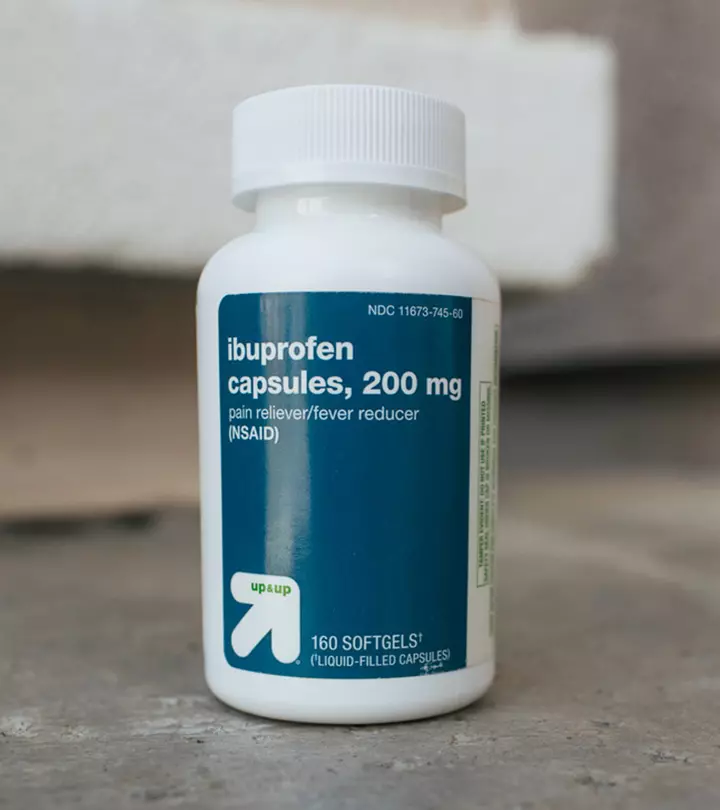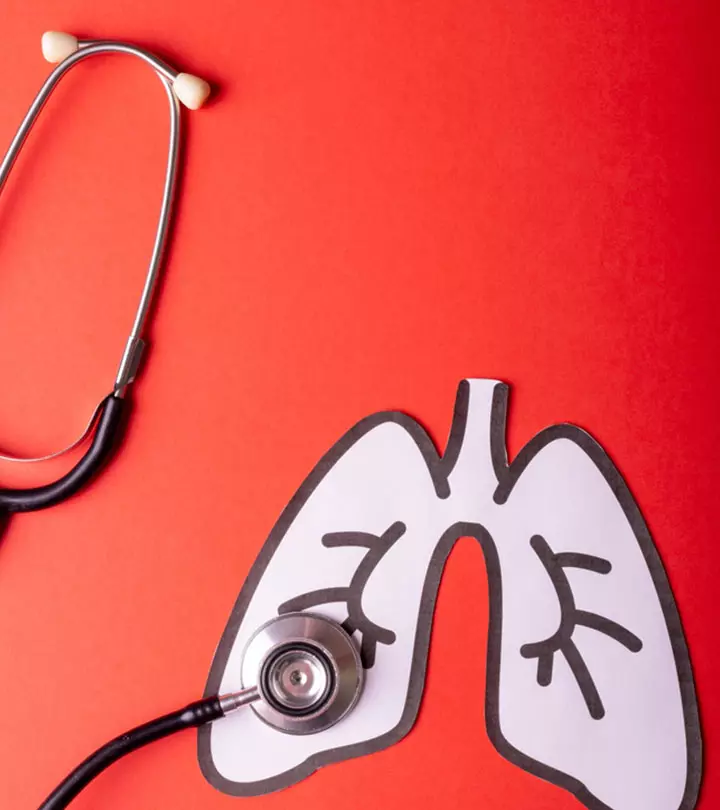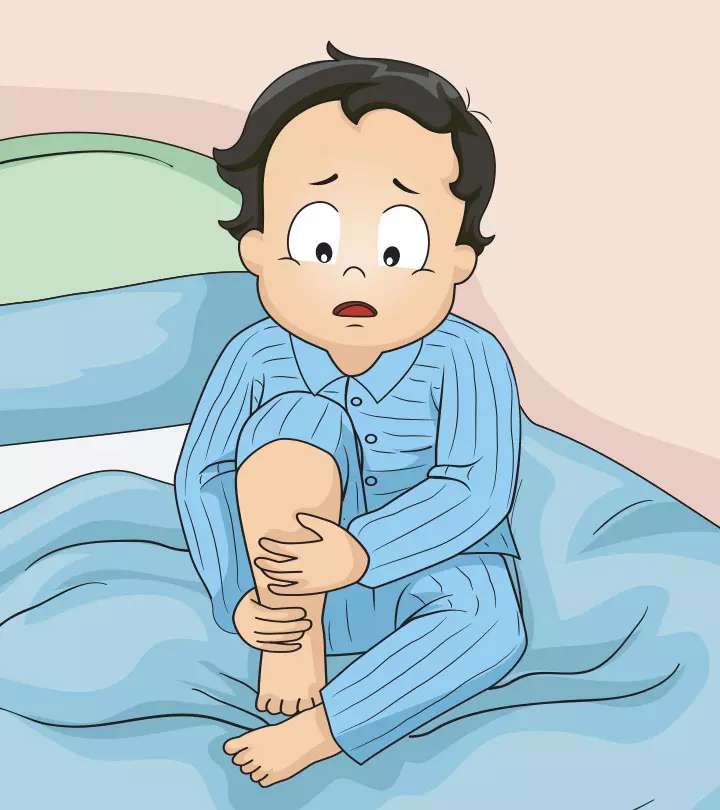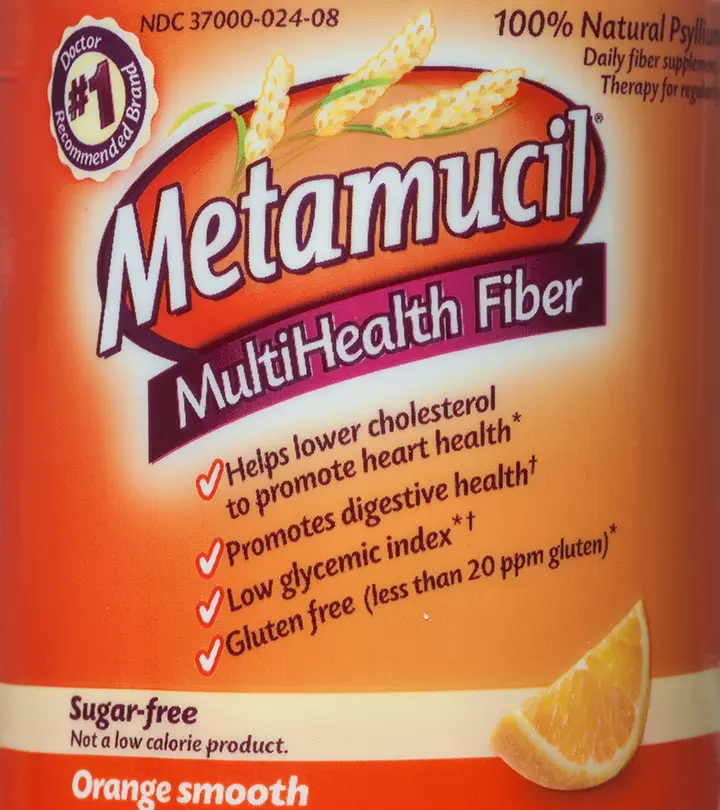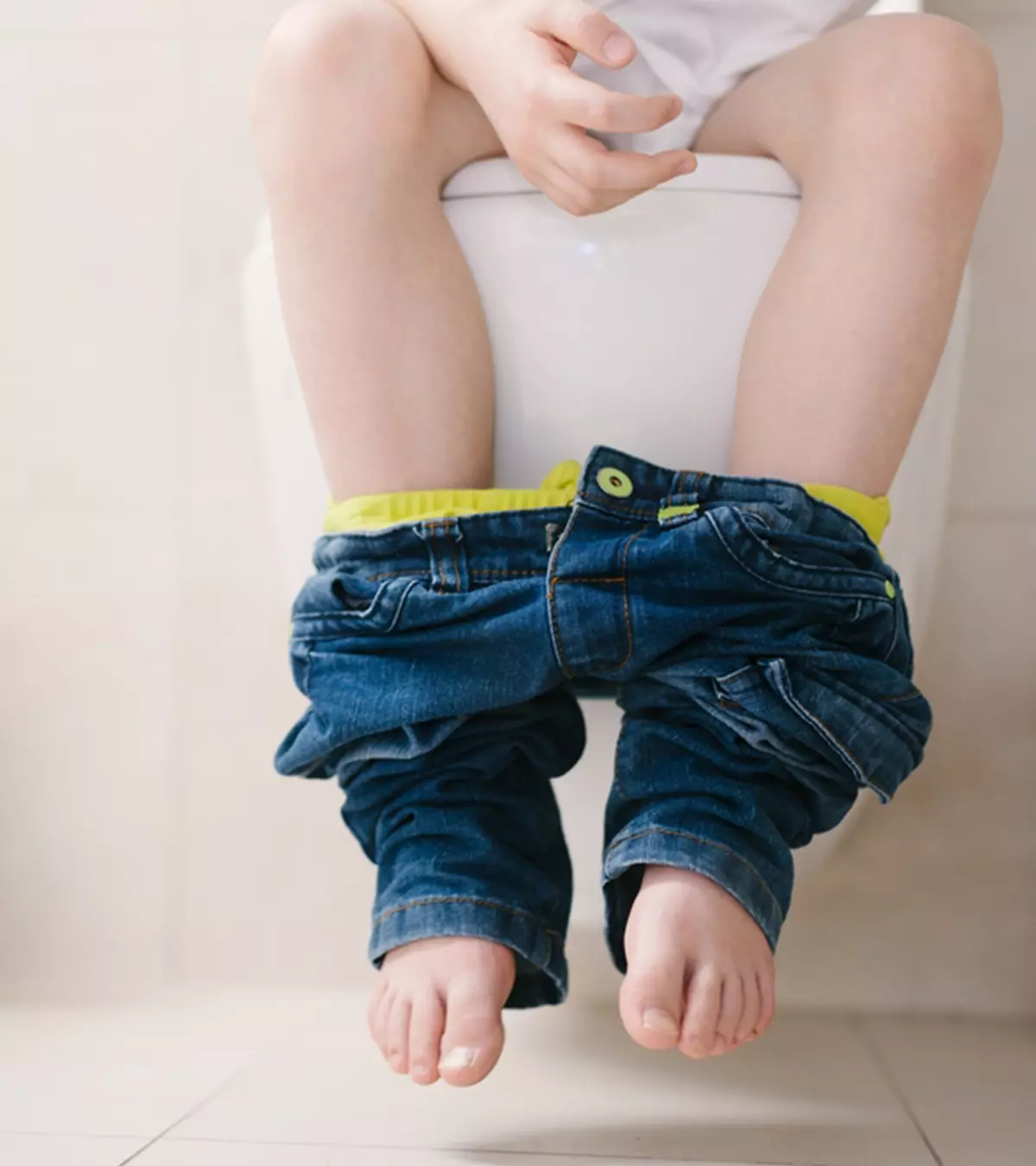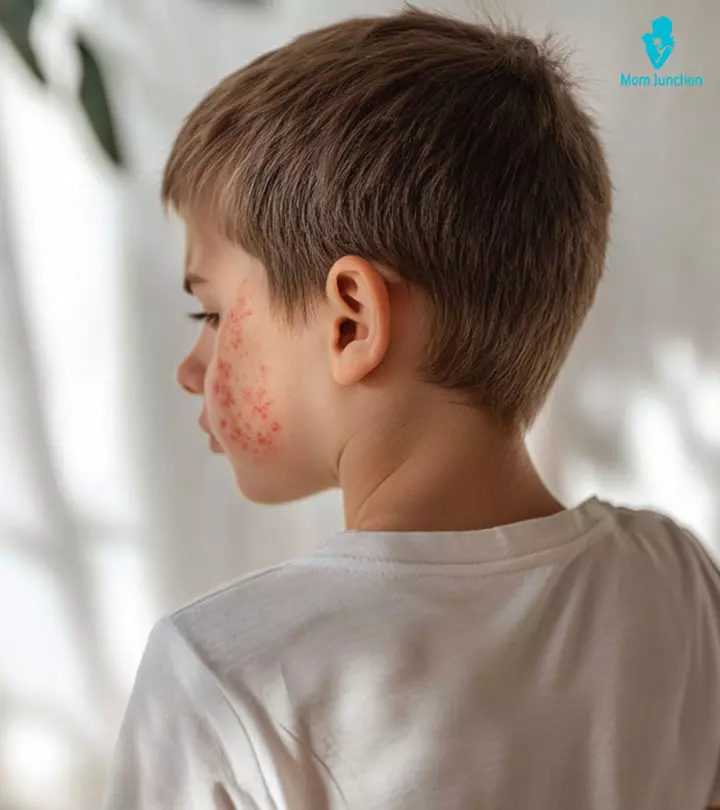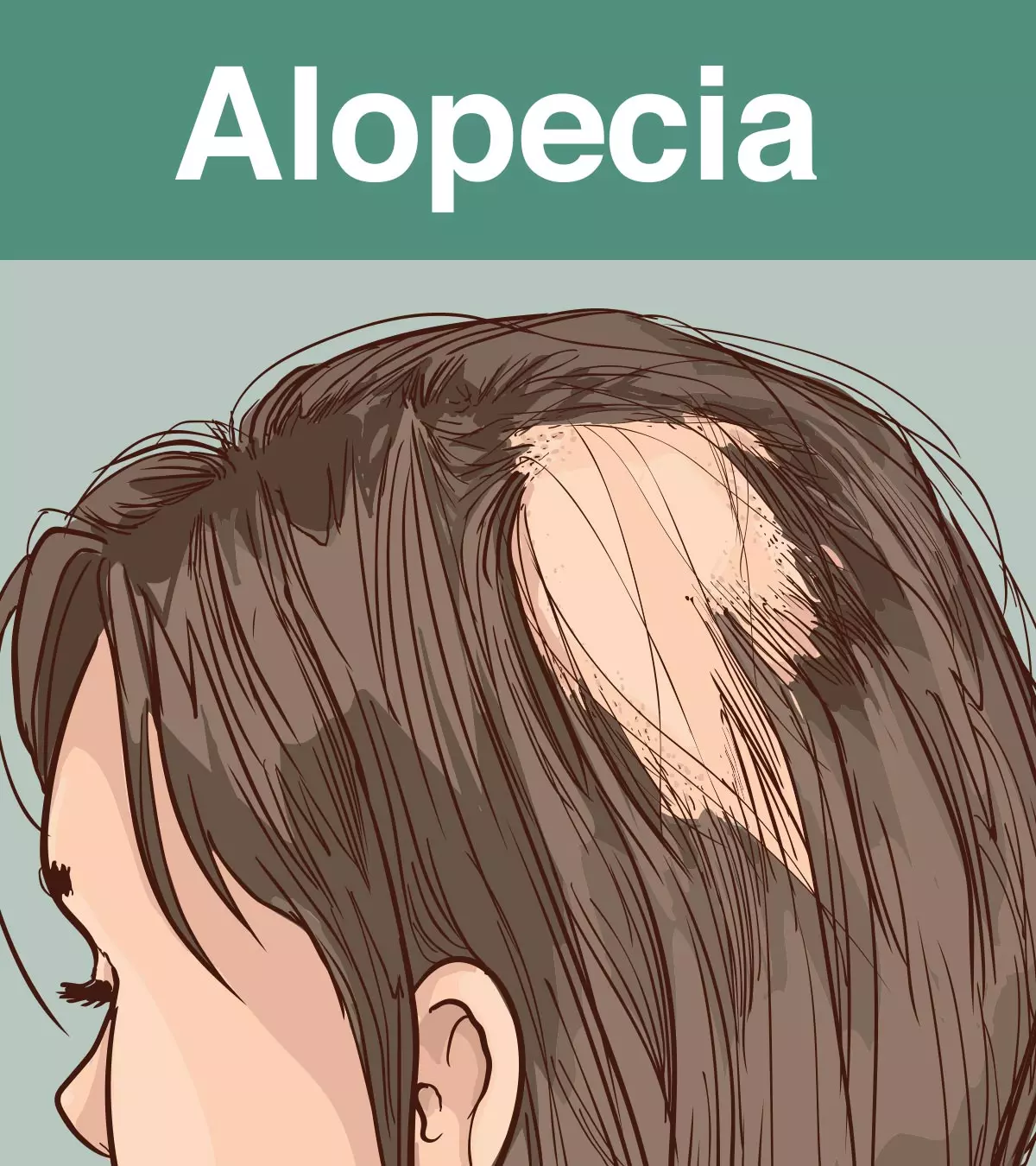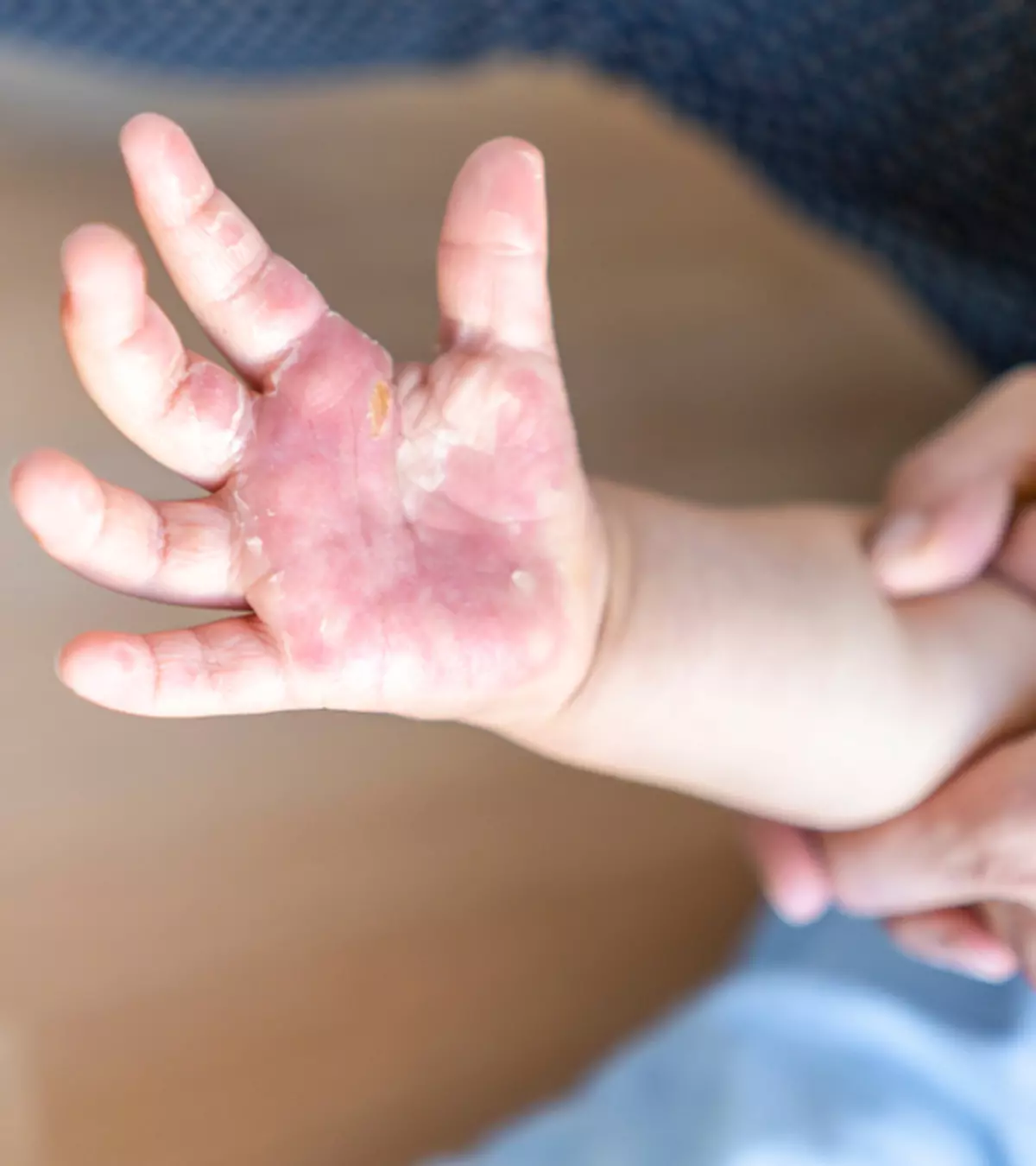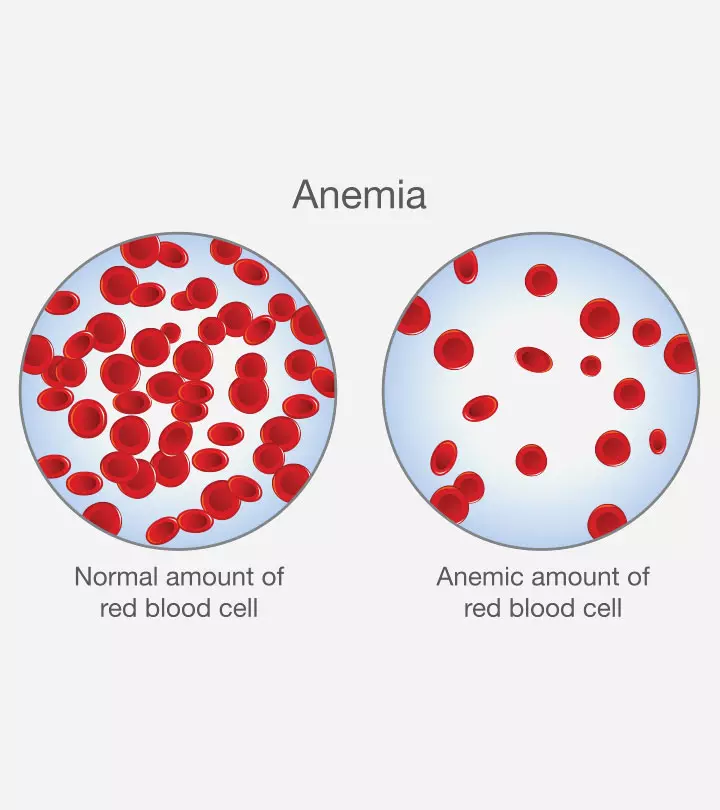
Image: iStock
Anemia is a blood disorder that occurs when children do not have enough red blood cells. Red blood cells have a protein called hemoglobin that carries oxygen to different body parts. When the body doesn’t produce enough red blood cells, there is insufficient oxygen in children’s bodies, making them weak and tired. The condition can also damage organs and tissues (1).

Anemia is a common disorder, occurring in around 20% of children in the US at some point in their lives. In addition, a study by the World Health Organization detailed that 269 million (39.8%) children aged 6 to 59 months across the globe have anemia. It happens when the body is not producing, losing, or destroying red blood cells quickly (2).
Read the post to know about the types, causes, symptoms, diagnosis, and treatment for anemia in children.
Key Pointers
- Lack, loss, or destruction of red blood cell production due to various reasons such as nutrient deficiency or certain medications can cause anemia in children.
- Pale skin and nails, feeling sleepy, weakness, and fatigue are common signs of anemia in children.
- Treatment of anemia may vary depending on type, severity, and underlying cause, such as diet changes, discontinuing certain medications, or supplements.
What Are The Types Of Anemia In Children?
There are several types of anemia — some are mild and temporary, while others are chronic and life-threatening (1) (2).
- Iron-deficiency anemia occurs when children’s bodies do not have sufficient iron to make hemoglobin. This condition may occur due to inadequate iron in the diet, poor iron absorption, or loss of excessive blood from the body.
- Hemolytic anemia occurs when the body destroys red blood cells faster than they are produced. The two types of hemolytic anemia are autoimmune hemolytic anemia (body’s immune system destroys the red blood cells) and inherited hemolytic anemia (conditions like sickle cell disease and thalassemia) (3):
a. Sickle cell anemia occurs when children’s bone marrow makes sticky, curved, and stiff red blood cells instead of normal, round, and flexible ones. This clogs the blood vessels and affects the oxygen flow, giving rise to pain and complications.
b. Thalassemia or Cooley’s anemia is an inherited blood disorder where the bone marrow starts making fewer red blood cells and abnormal hemoglobin.
- Aplastic anemia is a condition where the bone marrow fails to make new red blood cells.
- Megaloblastic anemia is characterized by large red blood cells caused due to folic acidi deficiency or vitamin B-12 deficiency. One type of megaloblastic anemia is called pernicious anemia, which is caused due to the improper absorption of vitamin B-12.
What Causes Anemia In Children?
Children can be anemic because of these reasons (4):
- Inability to produce enough red blood cells: Dietary deficiency could be a cause of iron-deficiency anemia in children. This could happen if children do not have enough iron or nutrients that are required to make red blood cells
- Destruction of many red blood cells: It could be due to an underlying condition or inherited blood disorder such as sickle cell anemia.
- Loss of red blood cells: The loss of blood may be long-term through stool or short-term through an injury. In girls, it may also be due to menstruation.
- Certain medications or infections also decrease the level of red blood cells or hemoglobin. (2).
- Children who drink a lot of cow’s milk may also have anemia if they do not eat a balanced diet (5).
What Are The Symptoms Of Anemia In Children?
The common symptoms in children with anemia are (2) (4):
- Pale and yellow skin
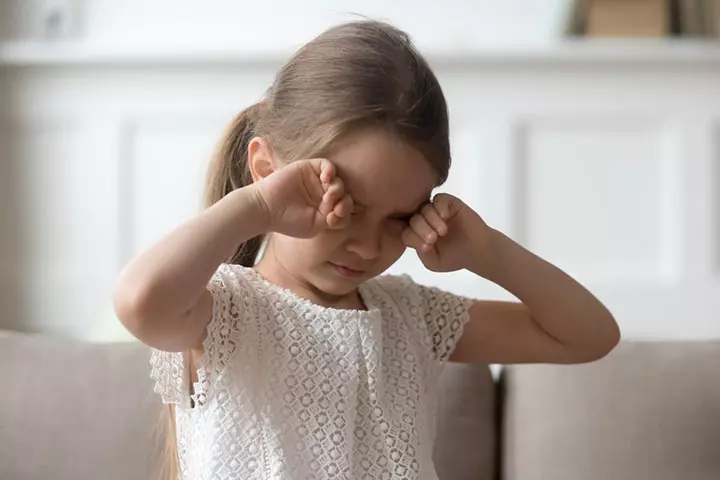
- Yellow skin and eyes, and dark-colored urine (in children with red blood cell destruction)
- Pale cheeks and lips
- Pale nail beds and lining of the eyelids
- Feeling of irritation
- Weakness and fatigue
- Feeling sleepy more often
Other symptoms of severe anemia are (2) (4):
- Breathlessness
- Increased heart rate
- Swelling in hands and feet
- Headaches
- Dizziness or vertigo
- Irregular menstruation
- Absence or delay of menstrual cycles
- Restless leg syndrome
- Sore or swollen tongue
- Enlarged spleen or liver
- Growth retardation and slow development
- Delayed wound healing
 Did you know?
Did you know?Who Is At Risk Of Being Anemic?
The risk factors for anemia in children include (2)
- Premature or low-birth-weight infants
- Living in poverty
- Inability to consume foods rich in iron
- Consuming too much cow’s milk
- Surgery or accident with blood loss
- Kidney or liver infections
- Diet low in iron, vitamins, and minerals
- Family history (inheritance of red blood cell disorder such as sickle cell anemia)
- Drinking unboiled water (causes parasitic infection leading to intestinal bleeding-induced anemia) (6)
- Infectious diseases, such as pneumonia and tuberculosis (6)
The graph below represents the findings of a study that examined the global prevalence of anemia among children. The study revealed that anemia is highly prevalent among children under ten, regardless of the type and underlying causes. It also highlighted that the prevalence of anemia peaks in the age range of five to nine years. Moreover, except for children aged one to nine, girls are more susceptible to prevalent cases of anemia than boys, as indicated by the graph.

Global prevalence of anemia among children per 100,000 population, by age and sex (2019)
Source: Burden of anemia and its underlying causes in 204 countries and territories, 1990–2019: results from the Global Burden of Disease Study 2019; Journal of Hematology & Oncology Point to consider
Point to considerHow Is Anemia Diagnosed In Children?
In most children, anemia is diagnosed during routine screening. Some diagnostic tests include:
- Physical examination where the doctor will examine children’s symptoms of anemia, such as pale skin and lips or increased heartbeat (7).
- Doctors will also want information about children’s diet, medications, and family history (1).
- Blood tests include (8):
- The first screening for anemia is done through the hemoglobin and hematocrit testiA blood test to determine the percentage of red blood cells in the blood. . It helps know the concentration of hemoglobin and the number of red blood cells in the blood.
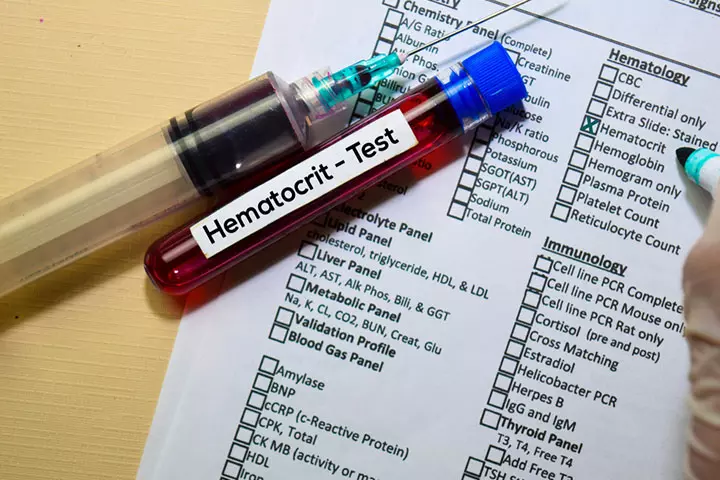
- Complete blood count gives more details about the blood. It helps the doctors understand the concentration of different blood cells and the size of red blood cells (mean corpuscular volume).
- Peripheral smear involves examining a smear of the blood sample under a microscope. It helps understand the type of anemia in children.
- Reticulocyte count allows doctors to examine the level of reticulocytes (immature blood cells) in a child’s body. A high reticulocyte count indicates too many red blood cells being lost, whereas a low reticulocyte count indicates not enough red blood cells being made.
- Bone marrow aspiration and biopsy: Cells from the bone marrow are taken with the help of a needle and examined to understand the bone marrow’s activity (7).
How Is Anemia Treated In Children?
The treatment of anemia depends on the (7)
- Cause of the condition
- Child’s age, general health, and medical history
- Severity of the condition
- Type of anemia
- Children’s tolerance for medications and treatment procedures
Anemia may be treated in the following ways (7):
- Giving supplements rich in folic acid, iron, and vitamin B-12 (6)
- Changing the diet
- Discontinuing medications that may be causing the condition
- Treating the disorder that may have caused anemia
- Blood transfusions
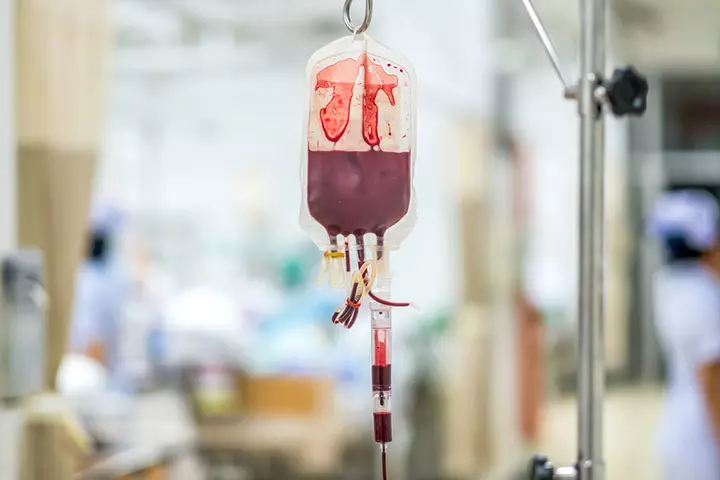
- Giving antibiotics to treat infections
- Removing the spleen, in case of hemolytic anemia
- Bone marrow transplant, in case of aplastic anemia
What Are The Home Remedies For Anemia In Children?
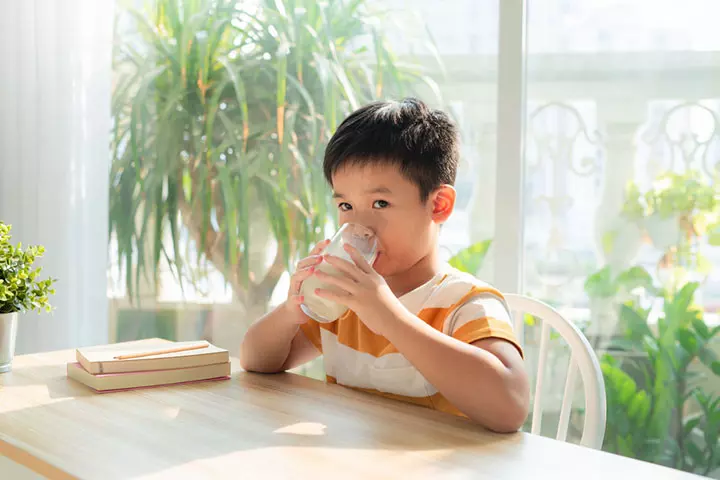
Some home remedies that may help treat a child with anemia are:
- Drinking beetroot juice regularly increases the hemoglobin level, as it is rich in folic acid (9) (10).
- Combinations such as bell pepper and bean salad, spinach with lemon juice, and fortified berries and cereals are good sources of iron that help treat iron-deficiency anemia (11).
- Consuming food prepared in iron utensils to treat anemia. This food will absorb iron from the vessel (21).
- Sugarcane molasses is rich in iron, so its consumption helps treat iron-deficiency anemia (12).
- Dates are rich in iron, vitamin C and fiber. Therefore, they help improve hemoglobin levels (13).
- Other iron-rich foods for kids such as red meat, organ meats, seafood, nuts, dark leafy vegetables, bananas, peas, and lentils can also help treat or manage anemia (14).
How Is Anemia Prevented In Children?
It is difficult to prevent anemia that is inherited. However, anemia related to iron and nutritional deficiencies may be prevented in the following ways (4):
- Do not give cow’s milk to children before they are one-year-old. The milk can cause blood loss in the stool and inhibit absorption in the intestine.
- Breastfed children get enough iron until the age of four months. After four months, infants need iron supplementation to help prevent anemia.
- Ensure that you give iron-fortified formula milk to your children if they are not breastfed.
- Do not give more than two cups of milk to children above one year. This will ensure they eat a balanced diet that fulfills their daily iron requirement.
- Ensure that your older children have healthy foods such as egg yolks, beans, meat, vegetables, nuts, and grains.
- Add sources of vitamin C to the diet because it enhances iron absorption in the body.
 Be watchful
Be watchfulAdditionally, regular screenings for anemia should be part of your child’s healthcare visits, especially in the early years and during adolescence. It’s also important for parents and caregivers to recognize symptoms of anemia, so they can seek help quickly if needed.
Frequently Asked Questions
1. What anemia is most common in children?
The most common type of anemia seen in children is microcytic anemiaiA type of anemia where the circulating RBCs are smaller than usual due to reduced hemoglobin. (15). Children with microcytic anemia with poor iron intake should go for dietary counseling and take iron supplements.
2. Can low iron cause behavior problems?
A research study on adolescent boys has shown that low levels of iron in the blood can be related to behavior problems (16). It could also cause cognitive impairment and affect their motor skills.
3. What level is considered anemic in kids?
According to the recommendations of WHO, the levels of Hb used to detect anemia are as follows (17):
| Anemia | ||||
| Population | Non-anemia | Mild | Moderate | Severe |
| Children (6-59 months) | 110 or higher | 110-109 | 70-99 | Lower than 70 |
| Children (5-11 years) | 115 or higher | 110-114 | 80-109 | Lower than 80 |
| Children (12-14 years) | 120 or higher | 110-119 | 80-109 | Lower than 80 |
4. What are the long-term effects of untreated anemia in children?
If anemia in children goes untreated, it can lead to long-term problems. Even mild anemia can affect a child’s energy levels, concentration, and learning ability. Chronic iron deficiency anemia can cause permanent developmental delays, resulting in learning difficulties and lower academic performances (20).
Anemia in children could be an indicator of other underlying diseases. Usually, mild anemia is asymptomatic and may not require treatment. However, chronic cases of anemia require prompt medical intervention to prevent further complications and adverse effects. Breathing difficulties, rapid heartbeat, lightheadedness, pale skin, or delay in wound healing are some of the common signs of anemia in your child. Hence, if you notice any such signs, it is best to speak to your child’s doctor and facilitate early diagnosis and proper management of the condition.
Infographic: How To Know If A Child Is Anemic?
From eating a diet low in iron to certain medications, illnesses, and family history of genetic conditions, there can be many causes of developing anemia in children. However, knowing the symptoms early on and prompt intervention can prevent fatal complications. The following infographic includes some common indications of anemia to help you provide proper treatment to your child.
Some thing wrong with infographic shortcode. please verify shortcode syntaxAnemia in kids can be scary, but this video will provide you with all the information you need to know to help your child.
References
- Anemia in Children.
https://www.rush.edu/kids/conditions/anemia-children - Anemia in Children.
https://www.urmc.rochester.edu/encyclopedia/content.aspx?contenttypeid=90&contentid=P02311 - Anemia.
https://kidshealth.org/en/parents/anemia.html - Anemia in Children and Teens: Parent FAQs.
https://www.healthychildren.org/English/health-issues/conditions/chronic/Pages/Anemia-and-Your-Child.aspx - Anemia caused by low iron – children.
https://medlineplus.gov/ency/article/007134.htm - Ai Zhao et al.; (2012); Prevalence of Anemia and Its Risk Factors Among Children 6–36 Months Old in Burma.
https://www.ncbi.nlm.nih.gov/pmc/articles/PMC3414569/ - Anemia in children.
https://childrenswi.org/medical-care/macc-fund-center/conditions/hematology-and-blood-disorders/blood-disorders/anemia-in-children - Diagnosing Anemia in Children.
https://www.stanfordchildrens.org/en/topic/default?id=diagnosing-anemia-in-children-161-1 - Dr. N. Gayathri Priya et al.; (2013); Beet root juice on hemoglobin among adolescent girls.
https://www.iosrjournals.org/iosr-jnhs/papers/vol2-issue1/C0210913.pdf?id=6977 - Pushpaanjali G. et al.; (2025); Effect of Beetroot Juice on Anaemic Patients – an Analytical Study
https://bbrc.in/bbrc/wp-content/uploads/2025/10/BBRC-113.pdf - Foods to Fight Iron Deficiency.
https://www.eatright.org/health/essential-nutrients/minerals/iron-deficiency - Rahi Jain and Padma Venkata Subramanian; (2017);Sugarcane Molasses – A Potential Dietary Supplement in the Management of Iron Deficiency Anemia.
https://pubmed.ncbi.nlm.nih.gov/28125303/ - Farahnaz Irandegani et al.; (2019); The Effect of a Date Consumption-Based Nutritional Program on Iron Deficiency Anemia in Primary School Girls Aged 8 to 10 Years Old in Zahedan (Iran).
https://www.ncbi.nlm.nih.gov/pmc/articles/PMC6927593/#:~:text=In%20addition%2C%20the%20amount%20of - Anemia.
https://familydoctor.org/condition/anemia/ - Mary Wang; (2016); Iron Deficiency and Other Types of Anemia in Infants and Children.
https://www.aafp.org/pubs/afp/issues/2016/0215/p270.html#:~:text=IRON%20DEFICIENCY%20ANEMIA-Microcytic%20anemia%20due%20to%20iron%20deficiency%20is%20the%20most%20commonbe%201%25%20to%202%25. - Sonia L. Robinson et al.; (2018); Iron Deficiency Anemia and Low Vitamin B-12 Serostatus in Middle Childhood Are Associated with Behavior Problems in Adolescent Boys: Results from the Bogotá School Children Cohort.
https://academic.oup.com/jn/article/148/5/760/4979593?guestAccessKey=0cbbe849-e015-4f5c-b9ea-6850ce9de93f&login=false - Haemoglobin concentrations for the diagnosis of anaemia and assessment of severity.
https://iris.who.int/bitstream/handle/10665/85839/WHO_NMH_NHD_MNM_11.1_eng.pdf - Anemia in Children.
https://www.cedars-sinai.org/health-library/diseases-and-conditions—pediatrics/a/anemia-in-children.html - Iron.
https://kidshealth.org/en/parents/iron.html - Betsy Lozoff et al.; (); Long-Term Developmental Outcome of Infants with Iron Deficiency.
https://www.nejm.org/doi/full/10.1056/NEJM199109053251004 - P. D. Prinsen Geerligs et al.; (2003); Food prepared in iron cooking pots as an intervention for reducing iron deficiency anaemia in developing countries: a systematic review.
https://pubmed.ncbi.nlm.nih.gov/12859709/
Community Experiences
Join the conversation and become a part of our nurturing community! Share your stories, experiences, and insights to connect with fellow parents.
Read full bio of Dr. Aldo Medina Serpa
Read full bio of Pragya Bhargavi
Read full bio of Dr. Ritika Shah
Read full bio of Dr. Joyani Das






